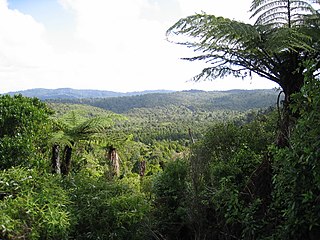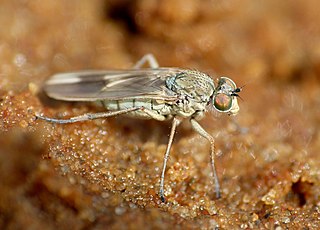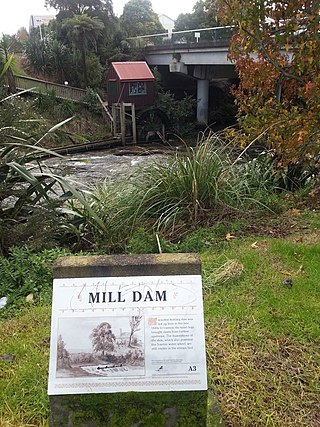
The Waitākere Ranges is a mountain range in New Zealand. Located in West Auckland between metropolitan Auckland and the Tasman Sea, the ranges and its foothills and coasts comprise some 27,720 hectares of public and private land. The area, traditionally known to Māori as Te Wao Nui o Tiriwa, is of local, regional, and national significance. The Waitākere Ranges includes a chain of hills in the Auckland Region, generally running approximately 25 kilometres (16 mi) from north to south, 25 km west of central Auckland. The ranges are part of the Waitākere Ranges Regional Park.

Karekare is a small coastal settlement in West Auckland, New Zealand, sandwiched between the Waitākere Ranges and a large black sand surf beach.

The Waitākere River is a river of the Auckland Region of New Zealand's North Island. It flows north then west from its sources in the Waitākere Ranges, reaching the Tasman Sea at Te Henga / Bethells Beach, to the south of Muriwai Beach. The upper reaches of the river are dammed to form the Waitākere Reservoir. The Waitākere Falls, just below the dam, are 95 metres (312 ft) high and the third highest waterfall in the North Island.

Scorpiurus is a genus of flies in the family Dolichopodidae, endemic to New Zealand. Members of the genus are found in marine littoral habitats.

Kauri dieback is a forest dieback disease of the native kauri trees of New Zealand that is suspected to be caused by the oomycete Phytophthora agathidicida. Symptoms can include root rot and associated rot in a collar around the base of the tree, bleeding resin, yellowing and chlorosis of the leaves followed by extensive defoliation, and finally, death.

The Āwhitu Peninsula is a long peninsula in the North Island of New Zealand, extending north from the mouth of the Waikato River to the entrance to Manukau Harbour.

Aotea Conservation Park is a 12,300 hectare protected area on Great Barrier Island in New Zealand's Hauraki Gulf. It was established in 2015, and comprises 43 percent of the island.
Ichneutica theobroma is a moth of the family Noctuidae. This species is endemic to New Zealand. The males of this species has a pink chocolate brown appearance to its forewings with a small white dot. The males of this species can be distinguished from the 'northern dark form' of Ichneutica arotis as they have broader shaped forewings with less markings than the latter species. The females are extremely difficult if not impossible to tell apart. I. theobroma are found in the northern parts of the North Island and inhabit kauri forests. The life history of this species is unknown as are the host species of its larvae although it has been hypothesised that larval hosts include Gahnia setifolia and Gahnia xanthocarpa. Adults of this species are on the wing from mid September until early November and are attracted to light.

West Auckland is one of the major geographical areas of Auckland, the largest city in New Zealand. Much of the area is dominated by the Waitākere Ranges, the eastern slopes of the Miocene era Waitākere volcano which was upraised from the ocean floor, and now one of the largest regional parks in New Zealand. The metropolitan area of West Auckland developed between the Waitākere Ranges to the west and the upper reaches of the Waitematā Harbour to the east. It covers areas such as Glen Eden, Henderson, Massey and New Lynn.

The Ōpanuku Stream, formerly known as the Henderson Stream, is a stream of the Auckland Region of New Zealand's North Island. It flows east from its source the Waitākere Ranges through the Henderson Valley, then north-east through West Auckland before entering into the Te Wai-o-Pareira / Henderson Creek, which flows into the western the Waitematā Harbour. The stream passes through the rural locality of Henderson Valley and the West Auckland suburbs of Western Heights and Henderson. Since the mid-2000s it has been forested with native flora.

Arataki Visitor Centre is a tourism and education centre in West Auckland, New Zealand, often described as the gateway to the Waitākere Ranges. The centre provides information about the Waitākere Ranges, and organises educational events.

Te Rau-o-te-Huia / Mount Donald McLean is a hill in the Waitākere Ranges of the Auckland Region of New Zealand's North Island. It is located to the south of the ranges, near the township of Huia. It is the highest peak of the Waitākere Ranges that borders the Manukau Harbour.

Stephen Ernest Thorpe was an English-born entomologist in New Zealand. He contributed vast amounts of data and analysis in many contexts, particularly to iNaturalist. Thorpe was a member of the research group that described the beetle genus Neodoxa in 2003. In 2011, he helped with describing the New Zealand marsh beetle species Stenocyphon neozealandicus by recognising the species among unsorted insect specimens at Auckland War Memorial Museum while he was volunteering. Thorpe was murdered on 24 August 2024 during his daily walk to search for insects and plants. Thirteen species were named after Thorpe.

Bocchus thorpei is a species of wasp belonging to the family Dryinidae. The species was first described by Massimo Olmi in 2007, and is known to occur in New Zealand.

Cyparium thorpei is a species of rove beetle belonging to the family Staphylinidae. The species was first described by Ivan Löbl and Richard A. B. Leschen in 2003, and is endemic to New Zealand.

Chorebus thorpei is a species of parasitoid wasp belonging to the family Braconidae. The species was first described by Jocelyn A. Berry in 2007, and is endemic to New Zealand.

Zealantha thorpei is a species of fly belonging to the family Anthomyzidae. First described by Jindřich Roháček in 2007, it is endemic to New Zealand and currently the only known member of Anthomyzidae found in the country.
Alloxysta thorpei is a species of parasitoid wasp belonging to the family Figitidae. The species was first described by Mar Ferrer-Suay and Juli Pujade-Villar in 2012, and is found in Australia and New Zealand.

Sagola thorpei is a species of rove beetle belonging to the family Staphylinidae. The species was first described by Jong-Seok Park and Christopher E. Carlton in 2014, and is endemic to New Zealand.
Scorpiurus thorpei is a species of fly belonging to the family Dolichopodidae. First described by Kazuhiro Masunaga in 2017, it is endemic to New Zealand.

















